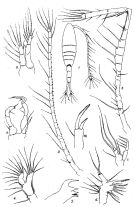|
|
 |
Fiche d'espèce de Copépode |
|
|
Calanoida ( Ordre ) |
|
|
|
Diaptomoidea ( Superfamille ) |
|
|
|
Acartiidae ( Famille ) |
|
|
|
Acartiella ( Genre ) |
|
|
| |
Acartiella tortaniformis (Sewell, 1912) (F,M) | |
| | | | | | | Syn.: | Acartia (Acartiella ) tortaniformis : Steuer, 1923 (p.12, figs.F,M); Sewell, 1932 (p.393); 1934 (p.81); 1948 (p.429); Silas, 1972 (p.650); Wellershaus, 1969 (p.269, 270, figs.F,M);
Acartia tortaniformes : Das & Das, 1980 (p.42, figs.F,M) | | | | Ref.: | | | Sewell, 1912 (p.346, figs.F,M) |  Issued from : R.B.S. Sewell in Rec. Indian Mus., 1912, 7. [Pl.XXI, Figs.1-10]. As Acartia tortaniformis. Female (from Bay of Bengal): 1, habitus (dorsal); 2, A1; 4, A2; 5, Md (masticatory edge); 6, Mx1; 7, Mxp; 10, P5. Nota: Head and 1st thoracic segment separate, 4th and 5th fused. Rostrum absent. Proportional lengths of urosomites and furca as 9:7:5:10; The 1st abdominal segment bears a row of spines transversally across its dorsal surface and scattered spines on the anterior half of its dorsal aspect. Caudal rami symmetrical and terminate in 4 setae, the 5th arising from the external margin, the 2nd is longer than the others and is somewhat stouter at its base; a accessory seta arises from the dorsal surface. A1 reach to the beginning of the caudal rami; there are 3 groups of small triangular spines on the posterior surface of the proximal segments, and with the exception of the distal 3 segments, all the others bear transverse rows of spines posteriorly. Th basal portion A2-segmented,, the 1st basal bears a 1 seta, the 2nd basal 2 setae, and the margins are fringed with hair; the endopodite appears to be fused with the 2nd basal segment and bears a crown of 7 setae; the exopodite consists of 1segment and bears 9 setae. P5 symmetrical. Male: 3, right A1; 8, P1; 9, P5. Nota: Abdomen 4-segmented. Right A1 modified to form a grasping organ; the knee-joint is situated between segments 18 and 19; the 17th segment bears a toothed-plate which is prolonged distally over the 18th segment, which bears a toothed-plate carrying numerous needle-like teeth, and distally has a pair of sharp fang-like teeth; the 19th segment bears 2 long spine-like tooth –plates armed with fine teeth on their anterior margins. Left P5 3-segmented, the right 4-segmented, arising from the basal segment of the right leg is a well-developed process, the endopodite.
|
 Issued from : S. Wellershaus in Veröff. Inst. Meeresforsch. Bremerh., 1969, 11 (2). [p.269, Fig.61-63]. After Sewell, 1912. Female: 62, P5; 63, urosome. Male: 61, P5.
|
 issued from : N.G. Das & S. Das in Chittagong Univ. St., 1980, II, 4. [p.43, Figs.1-6]. As Acartia tortaniformesFemale (from Karnafully River estuary): 1, habitus (dorsal); 2, A1; 3, P5. Male: 4, urosome; 5, A1, 6, P5. Nota Female: Head and thoracic segment 1 separated, 4th and 5th fused. A1 23-segmented, reaches upto the base of the caudal ramus. A2 endopod about the same length as exopod, the both unsegmented each, the former one bears a crown of 7 setae, and the latter 9 setae. A peculiar ‘V’ shaped twist present on the anal segment. Furcal ramus terminates in 4 long, marginal plumose setae, the 5th one arising from the external margin ; the 2nd one longer and stouter than others ; an accessory seta arises from the ventral surface ; internal margins of the rami densely haired. The right caudal ramus slightly longer than the left one. Nota Male: Urosome contained 1.54 times in that of prosome. A1 asymmetrical, right one modified to form grasping organ ; the knee-joint between segments 18 and 19 ; the 19th bears 2 long spine-like toothed plates armed with 5 teeth on either anterior margins. Left A1 resembles those of the female. P5 asymmetrical, the right P5 longer than the left P5. Left P5 uniramous and 3-segmented ; the basal segment bears a long outer seta, middle segment bears a short apical seta and the distal segment is flattened, curved inwards with 4 spines on inner margin. Right P5 biramous, 4-segmented ; a well-developed endopod arises from the basal segment, 2nd segment with a long outer seta, 3rd segment bears 2 unequal spines on its inner margin and this segment is curved inwards, the distal segment gradually tapers to bend upward bears a small spine on its outer margin and a stouter spine set about midway of the segment. The right caudal ramus much longer than the left one.
| | | | | Ref. compl.: | | | Sewell, 1948 (p.324, 429); Sewell, 1948 (p.324); Sarkar & al., 1986 (p.177, 178) | | | | NZ: | 1 | | |
|
Carte de distribution de Acartiella tortaniformis par zones géographiques
|
| | | | | | | Loc: | | | India (Calcutta), Bengladesh (Karnafully River estuary), Burma (mouth of Rangoon River, Hainguy Is.) | | | | N: | 3 | | | | Lg.: | | | (81) F: 1,4; M: 1,45; (1113) F: 0,9; M: 0,93; {F: 0,90-1,40; M: 0,93-1,45} | | | | Rem.: | estuaire.
Voir aussi les remarques en anglais | | | Dernière mise à jour : 15/12/2017 | |
|
|
 Toute utilisation de ce site pour une publication sera mentionnée avec la référence suivante : Toute utilisation de ce site pour une publication sera mentionnée avec la référence suivante :
Razouls C., Desreumaux N., Kouwenberg J. et de Bovée F., 2005-2026. - Biodiversité des Copépodes planctoniques marins (morphologie, répartition géographique et données biologiques). Sorbonne Université, CNRS. Disponible sur http://copepodes.obs-banyuls.fr [Accédé le 18 janvier 2026] © copyright 2005-2026 Sorbonne Université, CNRS
|
|
 |
 |






